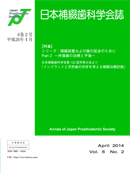Volume 6, Issue 2
Treatment and clinical outcomes of traumatized luxated teeth
Displaying 1-20 of 20 articles from this issue
- |<
- <
- 1
- >
- >|
Invited Articles
Treatment and clinical outcomes of traumatized luxated teeth
-
2014 Volume 6 Issue 2 Pages 117-118
Published: 2014
Released on J-STAGE: May 23, 2014
Download PDF (282K) -
2014 Volume 6 Issue 2 Pages 119-124
Published: 2014
Released on J-STAGE: May 23, 2014
Download PDF (967K) -
2014 Volume 6 Issue 2 Pages 125-132
Published: 2014
Released on J-STAGE: May 23, 2014
Download PDF (929K) -
2014 Volume 6 Issue 2 Pages 133-141
Published: 2014
Released on J-STAGE: May 23, 2014
Download PDF (1143K)
Prosthetic treatment plan for coexistent dental implants and natural teeth
-
2014 Volume 6 Issue 2 Pages 142-143
Published: 2014
Released on J-STAGE: May 23, 2014
Download PDF (507K) -
2014 Volume 6 Issue 2 Pages 144-148
Published: 2014
Released on J-STAGE: May 23, 2014
Download PDF (436K) -
2014 Volume 6 Issue 2 Pages 149-154
Published: 2014
Released on J-STAGE: May 23, 2014
Download PDF (1079K) -
2014 Volume 6 Issue 2 Pages 155-160
Published: 2014
Released on J-STAGE: May 23, 2014
Download PDF (1122K) -
2014 Volume 6 Issue 2 Pages 161-166
Published: 2014
Released on J-STAGE: May 23, 2014
Download PDF (1115K)
Original Articles
-
2014 Volume 6 Issue 2 Pages 167-175
Published: 2014
Released on J-STAGE: May 23, 2014
Download PDF (783K)
Case Reports (Specialist)
-
2014 Volume 6 Issue 2 Pages 176-179
Published: 2014
Released on J-STAGE: May 23, 2014
Download PDF (633K) -
2014 Volume 6 Issue 2 Pages 180-183
Published: 2014
Released on J-STAGE: May 23, 2014
Download PDF (630K) -
2014 Volume 6 Issue 2 Pages 184-187
Published: 2014
Released on J-STAGE: May 23, 2014
Download PDF (636K) -
2014 Volume 6 Issue 2 Pages 188-191
Published: 2014
Released on J-STAGE: May 23, 2014
Download PDF (555K) -
2014 Volume 6 Issue 2 Pages 192-195
Published: 2014
Released on J-STAGE: May 23, 2014
Download PDF (592K) -
2014 Volume 6 Issue 2 Pages 196-199
Published: 2014
Released on J-STAGE: May 23, 2014
Download PDF (649K) -
2014 Volume 6 Issue 2 Pages 200-203
Published: 2014
Released on J-STAGE: May 23, 2014
Download PDF (645K) -
2014 Volume 6 Issue 2 Pages 204-207
Published: 2014
Released on J-STAGE: May 23, 2014
Download PDF (669K) -
2014 Volume 6 Issue 2 Pages 208-211
Published: 2014
Released on J-STAGE: May 23, 2014
Download PDF (706K) -
2014 Volume 6 Issue 2 Pages 212-215
Published: 2014
Released on J-STAGE: May 23, 2014
Download PDF (654K)
- |<
- <
- 1
- >
- >|
